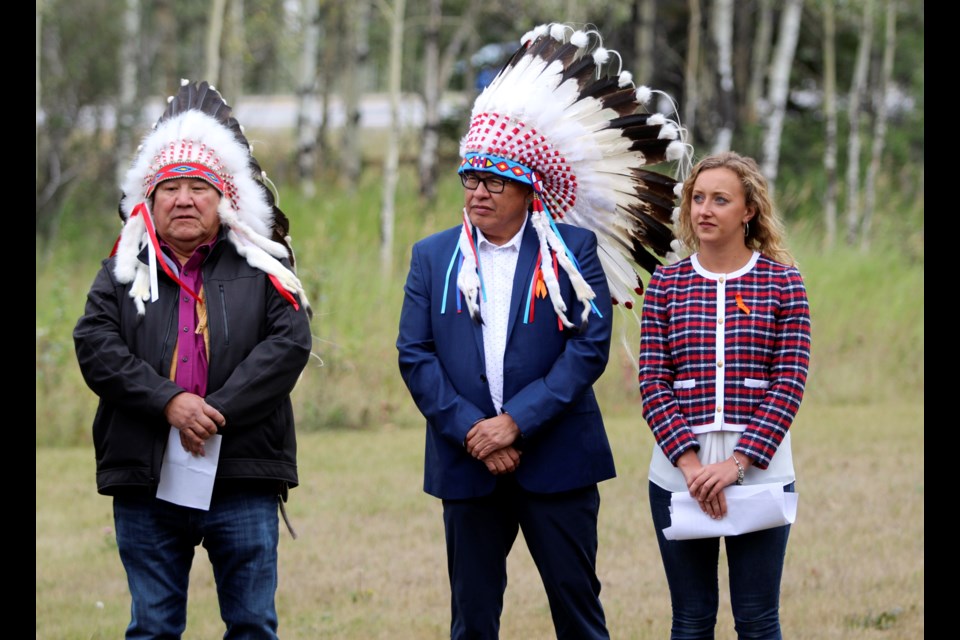CANMORE – The name of a mountain peak near Canmore was returned to its traditional Stoney Nakoda name, while a second one in nearby Banff National Park will also be renamed following consultation with Indigenous communities.
The peak near Canmore, Anû Kathâ Îpa which means Bald Eagle Peak in English, was officially renamed by the province. The second one closer to the Banff townsite – called Stoney Squaw – will also be renamed, with the province and Parks Canada working with Indigenous communities to find the best name.
While announced last September by Stoney Nakoda, the official government announcement on Monday (Aug. 23) will see the 1,279-metre high landmark updated on provincial and federal databases and maps.
“Finally, the day has come when justice has been done and this mountain will move forward,” Chief Clifford Poucette of the Wesley First Nation said. “The renaming is especially significant to the Stoney Nakoda Elders who have endured years and years of disrespect to their gender. I know they would be proud on this moment.”
Anû Kathâ Îpa was selected due to the migratory route for bald eagles, for which generations of the Stoney have gone to get their feathers. The area has always been recognized for its bald eagles.
A feature on Mount Charles Stewart, Anû Kathâ Îpa, was previously referred to by an unofficial derogatory nickname Squaw’s Tit.
"The Stoney Nakoda have been rightfully offended and disappointed by the derogatory association. This name has caused much pain and embarrassment for many years,” Chief Aaron Young of the Chiniki First Nation said.
“First Nations, we highly regard our women, our daughters and our granddaughters because they're the life givers. If it wasn't for them we wouldn’t be here. And to do any derogatory, to shame them is not our protocol. The racist and sexist term has finally been cast aside and the Stoney people are grateful.”
The efforts to rename the peak – known as the Peak Project – began in 2014 and were led by local lawyers and advocates as attempts were made to find a new formal name. The MD of Bighorn and Canmore councils threw their support behind the move to find a more appropriate name.
A previous effort to rename the peak now known as Anû Kathâ Îpa had been previously rejected by the Alberta Historical Resources Foundation board, but the new one was approved in the past year.
The event featured Banff Mayor Corrie DiManno. Miranda Rosin, the MLA for Banff-Kananaskis, was also on hand with Alberta Minister of Culture Ron Orr and the province’s Minister of Indigenous Relations Rick Wilson.
Wilson said it is an important step in the ongoing efforts of Truth and Reconciliation.
“This is an important step in reconciliation. We must recognize and celebrate Indigenous culture and the traditional names that reflect the true meaning and history of the land,” he said in a media release. “We must understand the past and honour these sacred places so we can continue to teach future generations about their ancestors and the places that connect them.”
Rosin admitted the contentiousness of the prior names, but it was important to officially change the name.
“Conversations about its pre-existing name have been stewing in our communities for years,” she said. “There are mere things in politics in 2021 that receive unanimous support from people, but nearly every Canmore-area local seems to agree how offensive, derogatory and shameful this mountain’s previous name was and how important it is to change.”
Elder Phillomene Stevens, who teaches Stoney Nakoda culture at local schools, said it is a joyous day to have the name changed.
“I feel so happy that I thank the creator for allowing this day to make it official.”
- With files from Jordan Small




